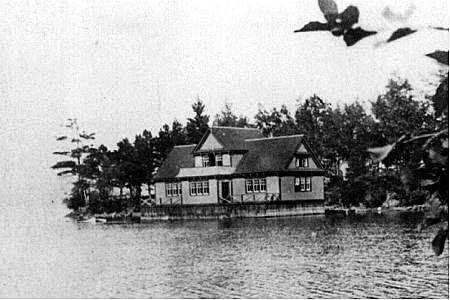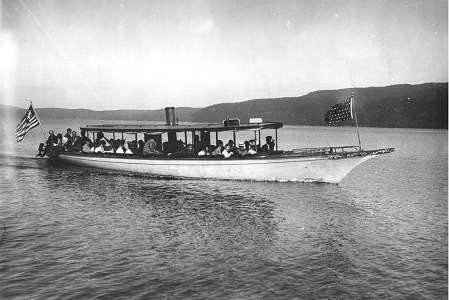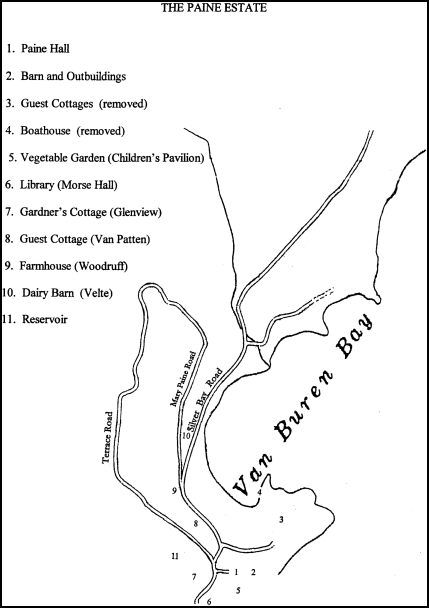

Benjamin Van Buren's Bay
Charles G. Gosselink
Contents Previous Next
 |
 Benjamin Van Buren's Bay Charles G. Gosselink Contents Previous Next |
Although they kept their house in New York City and usually spent the winter there, Silas and Mary Paine began to build on their land, seemingly with the intention of making Silver Bay their permanent home. First they built the beautiful Victorian cottage, which we know as Paine Hall, on a high point of land looking out over Lake George. There were fewer tall trees then and they must have had a clear view up and down the lake and have been able to see the steamboats coming and going at the Silver Bay landing. They put in a lovely formal garden behind the cottage and there were lawns and flowerbeds in the front, along the road, and of course there were the stone walls. The tower at the end of the point must have been built at that time. Behind the house were several smaller sheds, a large barn and carriage house, a chicken coop, and an icehouse.
 Library of Congress | |
| Van Buren Bay 1906 |
Early on, Paine had plans to develop a dairy farm on the northern part of his land and consequently in 1897 and 1898 he built both a farmhouse, at the top of the hill where Paine Road turns off of the Silver Bay Road, the present Woodruff cottage, and a barn, just down the hill, now the Velte house. Evidently, by the time the buildings were completed, Paine had decided that farming would not be practical on that land. He kept the farmhouse for guests and converted the barn into a large house with many bedrooms. His plan was to offer that house to the Fresh Air Fund so that underprivileged boys from New York City could spend the summer in the Adirondacks, and that was done during the summers of 1899 and 1900.[19] He must have used it as a guest house, as well, because Margaret Wishard, daughter of Luther Wishard, the founding inspiration of the Silver Bay Association, recalls that she was born in that house, "in a barn, like Jesus," on the kitchen table![20] The Fresh Air Fund project was not a total success, and so in 1900, Paine sold that house to John D. Davis.
While the major plans for a farm did not work out, the Paines still went a long way toward being self-sufficient in food. South of Paine Hall, where the children's pavilion and playground are located now, they had an extensive vegetable garden. There was an apple orchard on the hillside to the north of the house and cows were pastured in the meadow down by the lake where the Silver Bay Association cabins stand now. They provided fresh milk for many of the local cottagers and the chickens in the coop behind the house provided eggs.[21]
To manage this large estate, the Paines employed a large permanent staff. Leonard Middleton was responsible for the orchard and gardens. The Middletons lived in the present Glenview cottage, across the road from Paine Hall, where they raised their six children. Jim Maloney was the chauffeur and his wife Lena was the cook. Burton Fish, who lived in the house just north of the General Store, was responsible for the horses and wagons and sleighs. And there were several other grounds keepers and house servants.
 John Shattuck | |
| The Paine Vegetable Garden 1910 |
The Paines loved to entertain and there was a constant flow of visitors to Paine hall. Thornton Penfield was a guest in 1901. He traveled with a group of YMCA secretaries who were responding to Paine's offer to turn his hotel over to the YMCA to be operated as a Christian conference center. They arrived by train at Montcalm Station, Ticonderoga. Writing in 1958, he recalled, "Conveyance quickly came and we were all taken to Mr. Paine's home for a welcome and hearty breakfast. We tramped over the grounds and back three miles to Jabes Pond and, in the late afternoon, had a corn roast and a big bonfire down below the Paine house about where the tabernacle is now [the archery range today] while the colored help . . sang Negro spirituals."[22]
To accommodate their guests, the Paines built three more guest or rental cottages, two in the vicinity of the present archery range and one across from the entrance to Paine Hall. The latter was purchased by Dr. W. H. and Mrs. Jeannie Fundenberg of Pittsburgh in 1904. Peggy Hinck remembers staying with her mother and two aunts in one of the other houses in the summer of 1913 and then again in 1914, when her uncle Arthur Hollister died very suddenly in Ticonderoga. She remembers that out of consideration for her aunt Edna Hollister, whom they invited back to stay with them the following year, the Paines had the two houses removed.[23] One of these was given to the Silver Bay Association, and Louis Spelman describes how it was moved up a steep hill, over the stone wall, and then down the hill and a long distance to an area near the beginning of the Inspiration Point trail.[24] It is now known as Woodside Cottage, the home of Mark and Gail Rakowski. Aaron Middleton recalls that the second house had been built for Mary Paine's invalid sister. When she passed away, Silas Paine gave the house to his great-nephew Ralph Johnson, and he had it moved during the winter, across the ice and up the hill to a site just above Paine Road.[25]
The Paines, probably unintentionally, made another lasting mark on what had been Benjamin Van Buren's farm. They owned a beautiful launch, originally naphtha powered, large enough to carry 25 people, which they named "Oneita," and they had a boathouse on the eastern shore of the little bay just below their house. Over the years, people began to refer to Van Buren Bay, where the boat was kept, as Oneita's bay, then probably Oneita Bay, and now most commonly, if erroneously, Oneida Bay. And so Van Buren's name receded into history. Perhaps it is time to bring it back.

| |
 Library of Congress | |
|
Silas Paine's boathouse on Van Buren Bay in 1906 and the launch "Oneita" |
In 1921, Silas Paine died after a long illness, leaving Mary Paine with the Silver Bay house and estate. She continued to summer there, entertaining often and inviting old friends to stay with her. She died in 1937, leaving the proceeds of the estate to Princeton University in memory of their only son Harrison Spear Paine who had died in 1918. All three are buried in the cemetery at Valley View.

[19] John D. Velte, unpublished recollections, 1987, SBA Archives.
[20] Margaret Wishard, unpublished recollections, 1987, SBA Archives.
[21] Aaron Middleton, unpublished recollections, 1987, SBA Archives.
[22] Thornton B. Penfield, Memoirs, published for his family, 1959.
[23] Peggy Hinck, unpublished recollections, 1987, SBA Archives.
[24] Louis Spelman, Silver Bay As I Knew It, 1976.
[25] Aaron Middleton, unpublished recollections, 1987, SBA Archives. The house was moved in 1918.